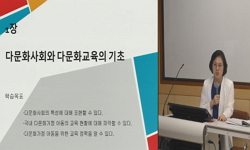The purpose of this study is to investigate the content and implementation of multicultural education at schools and thereby establish the basis for a new content system of multicultural education. To this end, this study analyzed the reports of multi...
http://chineseinput.net/에서 pinyin(병음)방식으로 중국어를 변환할 수 있습니다.
변환된 중국어를 복사하여 사용하시면 됩니다.
- 中文 을 입력하시려면 zhongwen을 입력하시고 space를누르시면됩니다.
- 北京 을 입력하시려면 beijing을 입력하시고 space를 누르시면 됩니다.

다문화교육 연구학교의 프로그램에 대한 비판적 분석 = A Critical Analysis of Multicultural Programs in Multiculture Research Schools
한글로보기https://www.riss.kr/link?id=A82339263
- 저자
- 발행기관
- 학술지명
- 권호사항
-
발행연도
2010
-
작성언어
-
- 주제어
-
KDC
300
-
등재정보
KCI등재
-
자료형태
학술저널
- 발행기관 URL
-
수록면
29-60(32쪽)
- DOI식별코드
- 제공처
-
0
상세조회 -
0
다운로드
부가정보
다국어 초록 (Multilingual Abstract)
The purpose of this study is to investigate the content and implementation of multicultural education at schools and thereby establish the basis for a new content system of multicultural education. To this end, this study analyzed the reports of multicultur research schools, based on multicultural citizenship as the goal of multicultural education, the concept of culture guiding multicultural education, and Bank`s discussion of multicultural curriculum. The results of the analysis can be summarized as follows. Frist, the multicultural education at the schools surveyed basically has aimed to facilitate the recognition of cultural difference for the development of cultural identity and a better understanding of other cultures. Second, multicultural education programs at schools have been organized and conducted by drawing upon the anthropological concept of culture. Third, such multicultural curriculum have been implemented through the “contribution approach” and the “additive approach.” The contribution approach to multicultural education maintains the existing curriculum mainly in curricular and extracurricular activities. The additive approach calls for bringing multicultural elements into each of the school subjects. In-depth interviews helped see the limit of contents and operation of multicultural education programs. The interviews showed that multicultural education was no more than cultural experience for children and parents from multicultural families and ordinary students. Based on the results of the study, suggestions have been made regarding the future direction of multicultural education and its content system.
동일학술지(권/호) 다른 논문
-
2004년~2008년 국가수준 사회과 학업성취도 평가 성취수준별 대표문항 분석 연구
- 한국사회과교육학회
- 길현주 ( Ghil Hyun Joo )
- 2010
- KCI등재
-
- 한국사회과교육학회
- 박영석 ( Young Serk Park )
- 2010
- KCI등재
-
프랑스의 학교 시민교육에 관한 연구 -한국의 학교 시민교육에 시사하는 바를 중심으로-
- 한국사회과교육학회
- 송용구 ( Yong Goo Song )
- 2010
- KCI등재
-
- 한국사회과교육학회
- 옥일남 ( Il Nam Ok )
- 2010
- KCI등재




 KCI
KCI KISS
KISS






